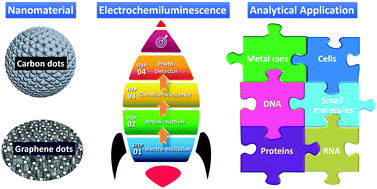Carbon-based dots for electrochemiluminescence sensing
Abstract
Carbon materials based quantum dots, mainly including carbon and graphene dots, with wonderful optical, electrical and chemical properties have greatly boosted the development of advanced sensors and analytical chemistry. Electrochemiluminescence (ECL) sensors based on carbon and graphene dots have shown promising potential and rapid developments in recent decades and have also attained great achievements. Deep insight into the applications of carbon and graphene dots in ECL sensing platforms will benefit the design of advanced sensors in the future. In this review, we aim to give a brief overview of carbon and graphene dots with versatile roles in the fabrication of ECL sensors. A general description of the basic ECL mechanisms, main synthesis routes of carbon and graphene dots, and a series of sensing approaches for the detection of targets including metal ions, small molecules, proteins, DNA and cells will be presented. In addition, recent developments of ECL sensors made of carbon-based dots, relevant signal amplification methodologies and an outlook for the construction of highly sensitive ECL sensors based on various carbon-based dots are also discussed.

- This article is part of the themed collections: 2020 Materials Chemistry Frontiers Review-type Articles and Carbon Dots


 Please wait while we load your content...
Please wait while we load your content...